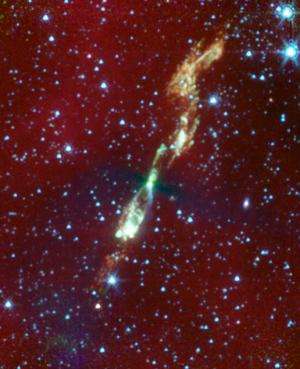The young star forming region L1157 as seen by the Spitzer Space Telescope. A new chemical study has been able explain the relative abundances of water and ammonia in this region. Credit: NASA/JPL-Caltech/UIUC
(PhysOrg.com) -- Complex molecules, including many organic species, exist in a wide range of environments in the cosmos, and are especially abundant in giant molecular clouds of gas and dust where new stars form. The rich chemistry underway in these clouds, and in the dense disks of material around young stars, creates molecules are ingredients in living systems. Astronomers use radio, millimeter, and infrared wavelength telescopes to detect the distinct spectral lines signatures of these molecules. But what determines the relative abundances of these molecules in the first place?
CfA astronomer Izaskun Jimenez-Serra and her colleagues have developed models for chemical processes that are appropriate for the conditions in astrophysical scenarios, including the earliest stages when the gas is extremely cold and just beginning to form complex species. They take into account three important factors: the dust grains on which the reactions occur before the gas evaporates from the surface, the extremely cold temperatures found in most sources (often less than minus 250 degrees Celsius), and the influences of shocks and radiation that develop as young stars in the clouds form and begin to mature.
The astronomers combine their models with new observations from the Herschel Space Observatory, including measurements of water, formaldehyde, ammonia, and methanol in the vicinity of very young, small stars. One of the longstanding puzzles has been the relative abundance of water and ammonia in these regions, these species being two of basic building blocks for more complex molecules. Their results show that the observed differences in the abundances of these species are due primarily to the temperatures of the regions under study. Water is frozen onto grains at extremely low temperatures, for example; ammonia is destroyed when temperatures exceed about 4000 degrees Celsius. A shock generated by outflows from the new star can act to heat the dust and gas, and thus affect the temperatures. The new results represent the first time that modeling of water and ammonia from initial conditions has been successfully achieved.
Provided by Harvard-Smithsonian Center for Astrophysics























